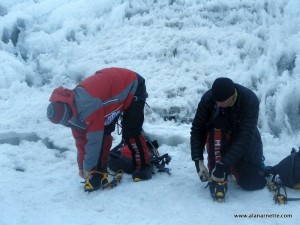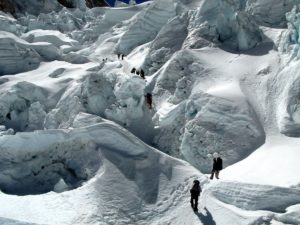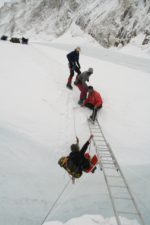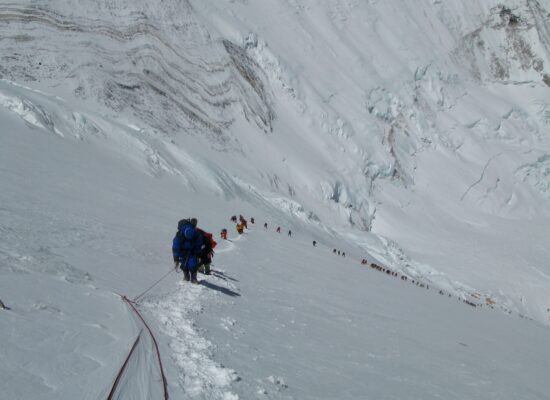This is the late April Everest 2024 Weekend Update. The headlines are significantly more positive than last weekend: Permits are a bit higher, which is good for the local economy but not so good for the mountain. The fixed ropes, aka the route, are all the way to Camp 2, thus opening the path for Sherpas to establish the upper camps and clients to begin acclimatizing.
Each weekend during the season, I’ll post a “Weekend Update” summarizing the main stories from the past week and what to expect next.
Big Picture
Well, the Everest permits have picked up and are close to last year’s total. Nepal issued 203 new Everest permits just this past week, bringing the total on Everest to 352, above the 319 issued as of April 17 last year. It appears that many teams are arriving much later than in previous years, partly due to acclimatizing at home using altitude tents, thus reducing the length of the Everest climb by weeks.
In a bit of a surprise, climbers from India have dropped while the US and China are the top two again, thus far. The top five nationalities climbing Everest this 2024 spring season are the United States: 65, China: 63, the United Kingdom: 28, India: 19 and Japan:19. Last year, the top five at the end of the season were the United States: 89, China: 97, India: 40, Canada: 21 and the United Kingdom: 19.
Last Week
The route through the Khumbu Icefall, the gateway to climbing to the Nepal summit, has reached Camp 2. It’s said to take two hours longer than usual to navigate the route to Camp 1. The Icefall Doctors for this season included Ang Sarki Sherpa, Dawa Nuru Sherpa, Pemba Tshering Sherpa, Ngima Tenzi Sherpa, Ngawang Chimmi Sherpa, Dawa Chirri Sherpa, Dawa Jangbu Sherpa and Mingma Gyaljen Sherpa.
Now, the question is when will the ropes and anchors be deposited at Camp 2 so the rope fixing team can fix the route to the summit. Discussions are underway with the Nepal government to allow helicopters to ferry loads to Camp 2 instead of having the Sherpas carry the loads through what is considered a more difficult and longer Icefall than usual. This would be a wise decision.
From the good news department, the Joint Typhoon Warning Center reports, “No Active Tropical Warnings in the Northwest Pacific, North Indian Ocean, Central Pacific, Eastern Pacific, or Southern Hemisphere.” Good news, to be sure, but we still have six weeks to go in this spring season. Typhoons usually develop in early May, but these days, the weather is so unpredictable that anything goes.
Using a convenient feature on the Meteoexploration weather website, the “hindcast,” Everet summits winds were reasonably low, around 30 mph/48 kph last week. Usually, teams will not go for summits with sustained winds above 30 mph. Good winds, but those temps are bone-chillingly cold at -30C/-22F. That puts the windchill at -48C/-55F. Climbers: don’t forget your long underwear! 🙂

Next Week
The delay in getting the ropes through the Icefall hasn’t created significant issues for the commercial teams. Climbing the Seven Summits noted on their blog, “Our Everest summit team have kept busy over the past few days keeping their acclimatization by doing hikes up Pumori and keeping skills current with lots of practice of ladder crossing, fixed line ascension and rapelling on the glacier by camp. They will now start preparing to head uphill on their first rotations now that the icefall route is fixed and open. A delayed start but not a big deal in the scheme of the expedition.”
Teams will take their first steps into the Khumbu Icefall as soon as today. Adventure Consultants said, “We will climb part way up the Khumbu Icefall, leaving Camp at 4 a.m. Consider it a dress rehearsal for the move we will make up to Camp 1 when we are ready.”
IMG has already sent Sherpas to establish Camp 2 in the western Cwm: “we had 6 Sherpas carry to Camp 2, and our Sherpa Camp 2 cooks moved up to Camp 1 to acclimatize (yes, sherpas need to acclimatize too!). All the sherpas and climbers will take a rest day tomorrow, with the plan to move up to Camp 1 the following day.”
The latest word was the border would open on April 17. Well, that date was missed, and Adventure Peaks switched to the Nepal side, citing the delay. However, usual Tibet-side commercial teams like Furtenbach Adventures and Alpenglow tell me everything is fine and they are on track to climb in Tibet this season. Adrian Ballenger told me directly:
Just fyi we on track and things still matching what CTMA have been saying for quite some time. Delayed opening to last week of April. We all have our visas and are on track to arrive chengdu on 28th! Will let you know if any hiccups but for now, teams really had a long time to plan for this. No surprises yet.”
By the way, many of you enjoyed my podcast interview with Ryan, the 19-year-old climbing Everest with Madison Mountaineering this spring. You can follow him on his almost daily video log on his YouTube channel. Full disclosure: Ryan is one of five Summit Coach clients on Everest this year.
Ropes to the Summit?
For reference, in 2021, by April 18th, the fixed ropes have been set to the Yellow Band around 24,000 feet, one of the latest dates in modern times. This year, they are at Camp 2 with no ropes positioned there to finish the route to the summit. With the delay in getting the route to Camp 2, anxiety rises each day the rope doesn’t reach the summit. In modern times, the rope-fixing teams reached the summit around May 10, opening the mountain to commercial team summit around the third week of May. Specifically, 80% of all Everest summits occur between the 15th and the 27th of May. Slicing it even finer, May 19th is the day on the Nepal side.
I went back 13 years to see the date the ropes reached the summit on the Nepal side, and May 10 is about right. This year, it will take good weather and mountain conditions to have the rope there by the 10th, but never underestimate what the Sherpas can do. Seven Summits Treks is contracted to fix this season’s route from C2 to the summit.
- 2023: May 12
- 2022: May 7
- 2021: May 7
- 202: Closed due to COVID
- 2019: May 14
- 2018: May 13
- 2017: May 15
- 2016: May 11
- 2015: The season ended early after the earthquake
- 2014: Season ended early after 16 Sherpas Deaths in the Icefall
- 2013: May 10
- 2012: May 18
- 2011: May 13?
- 2010: May 5
Glamping
In the “if you got it, spend it” department, the Himalayan Times reports that Neerja Birla, 52, the wife of Aditya Birla Group’s billionaire chairman Kumar Mangalam Birla, the seventh richest person in India, will climb the trekking peak Lobuche with Seven Summit Treks’ Chairman Mingma Sherpa, Dawa Phinjo Lama Bhote and Indian climber Arjun Vajpai. According to the report, she flew into Tribhuvan International Airport on a private jet on Thursday and immediately took a helicopter flight to Lukla.
Climbing with Elite expeditions, Qatari royal family member Sheikha Asma Al Thani and Coronado, California Mayor Richard Bailey are targeting Everest this season. She is the first Qatari woman to scale Mt Everest, K2 and Lhotse and the first Arab woman to reach the summit points of Kanchenjunga and Manaslu. She has already completed seven of 800ers. Bailey, who climbed with Elite Expeditions last year, had to abandon his effort. Of the twenty-nine members, eighteen summited. Twenty-four Sherpas supported them.
Other 800ers
This season of “other 800ers” is a bit quiet this year. After much activity on Annapurna and Makalu, summits have slowed down. We may see the rope team top out on Dhaulagiri in the next couple of weeks, followed by member summits, but this is usually climbed in May. One climb of note was by German Norrdine Nouar, 36. He summited Anna without O’s or Sherpa’s support but did use the infrastructure set on the route by Seven Summits treks. He will now move to Everest. He told excellent mountain journalist Stefan Nestler about his strategy to avoid crowds:
I have two options. Either to be one of the first and ascend just behind the rope-fixing team, setting off around four hours before the people wearing masks the night before. Or I can take advantage of a potential second or third weather window when the big rush is gone and the crowds have already dispersed or are on their way down. However, this depends very much on how robust and well acclimatized my body is and whether the acclimatization on Annapurna was sufficient.
Another No O’s Everest attempt will be by Kenyan Cheruiyot Kirui.

There were no injuries from what is termed a “massive” avalanche on Manaslu near Birendra Lake, which caused the lake to overflow into the Budhigandaki River. Lakpa Temba Sherpa, supporting other climbers, told the OnlineKhabar, “It didn’t even rain, but there was a flood. After a while, it became known that the water of Birendra Lake had flooded. It was as if we were crossing the bridge connecting Samdu village and Samagaon, and the flood swept away that bridge. It seems that we were saved by fate. There were also two to four yaks in that direction. Later, those yaks were not seen. It seemed that they had been washed away in a flood.” The climbers are now at Manaslu base camp.
Nepal Permit Update
The permitting really picked up this past week. As of April 19, 2024, Nepal has issued 749 climbing permits to 81 teams for 24 peaks. Last year, as of April 17, 2023, Nepal had issued 771 climbing permits to 87 teams for 23 peaks. This is the current 2024 tally for the 8000ers:
| 8000er | Teams | Male Clients | Female Clients | Total |
| Annapurna I | 3 | 14 | 11 | 25 |
| Dhaulagiri | 2 | 20 | 8 | 28 |
| Everest | 33 | 287 | 65 | 352 |
| Kanchenjunga | 3 | 20 | 11 | 31 |
| Lhotse | 7 | 64 | 8 | 72 |
| Makalu | 4 | 34 | 11 | 45 |
| Manaslu | 1 | 2 | 0 | 2 |
| TOTALS | 52 | 439 | 112 | 551 |
As for the nationalities climbing Everest this 2024 spring season, there are the top ten:
- United States: 65
- China: 63
- United Kingdom: 28
- India: 19
- Japan:19
- Russia: 17
- Australia: 10
- Canada: 10
- France: 7
- Nepal (non Sherpas): 7
With teams now going higher, let’s look at their first steps:
First Steps in the Icefall
Anxiety
You set your alarm for 3:30 am, knowing it was unnecessary as you’ve been awake with anticipation for the last two hours. Over last night’s dinner, the guides announced that today would be the first climb into the Icefall. Immediately, your anxiety level ratcheted up a notch—the Khumbu Icefall. You have seen so many pictures and a few videos and recently studied it from Kala Patar, Camp 1 on Pumori, and your base camp tent. But now it was time for the real thing.
You sit up in your sleeping bag and push the squishy headlamp-on button. The bright light shows your clothes laid out on the tent floor. You did that before going to sleep. Slowly, everything feels slow now; you pull on your climbing clothes. This is just a trip halfway up to the Football Field, but it still requires warm layers, gloves, boots, crampons, harness, jumar, cow’s tail, ice axe–the works. The three-person tent that seemed so big when you arrived now seems like a closet as you swing your legs off the mattress and pull on your pants. Your arms hit the sides as your top layer slides on. The moisture built up through the night on the tent ceiling falls gently on your head. “Well, I guess that’s my morning shower.” You mutter to no one.
Scooting to the door, you pull your boots into the tent, cursing at not having the foresight to keep them inside so they wouldn’t freeze. Now, you would pay the price with ten minutes of close combat–you against your boots—yet another lesson on high-altitude climbing. Finally, dressed for action, you stumble outside your tent only to trip over a guy line. “Damn, and I’m going to climb Everest?” you mutter to yourself. Standing in the cold, crisp air, you pause. Looking around, you see your teammates performing the same circus act.
Can’t Eat
Glancing at the Icefall, you see a string of headlamps softly glowing in the moonless night; um, someone is already up there. Probably Sherpas carrying a load to Camp 1 or Camp 2. You hear the low hiss of stoves as the cooks are making breakfast. Once again, you send a thought of gratitude for how hard the cook team works, getting up so early to send the Sherpas out with a full stomach, and now the team members. It is cold, but you are not cold. Looking at your yellow 8000-meter boots, the contrast against the snow is vibrant. Without thinking, a smile grows on your face. You are about to enter the Icefall.
The Sherpas gather by the cook tent, eating Tsampa, an unidentifiable rice, milk, and sugar concoction. They eat with the enthusiasm of a starving teenager. You walk over and enter the dining tent, seeing the cooks have already brought toast and a boiled egg for each climber. You spread some jam on your toast and stare at the egg. A teammate pushes some coffee your way. A grunt is all you can muster.
Go!

Without warning, the Sherpas enter the tent, calling out names. Not sure if you are being summoned or punished, you stand up quickly and follow your personal Sherpa, Dawa. You walk together to the puja altar, where the sweet smell of burning juniper fills the air.
Dawa approaches the smoke. He bows his head and then raises his right arm with an open palm. He smoothly swipes at the smoke, bringing it toward his face. He repeats the movement two more times as he asks for safe passage for himself and everyone on Everest today. Understanding the meaning, you follow his lead.
Dawa sets a brisk pace through the maze of paths in base camp. Switching on your headlamp, you follow closely but are still unsure of the correct turns. Crampon Point is your destination. With the finesse of a lightweight boxer, Dawa bobs and weaves between the tents. He dodges a yak standing on the trail, careful not to touch the sleeping beast.
You soon reach the perimeter of base camp and step onto a flattish section of the Icefall. You were here a few days ago to run through your gear on the obstacle course, but it is for real this time. The route becomes circuitous, up and down small ice hills, stepping over small sections of running water, and maneuvering around growing ponds. Careful not to get your boots wet, you take big steps while Dawa seemingly floats over them.
Doubts
Your breathing increases. Tiny drops of sweat form on your chest, your forehead. The doubts begin again. “Oh my God, if I’m struggling just to get to Crampon Point, what will …” You stop yourself, remembering the value of mental toughness.
You and Dawa arrive at Crampon Point with the energy of an Indy race car coming into the pit for a tire change. Taking your crampons out of your pack, you kneel on one knee to attach the spikes to your oversized boots. Right, then left; thread the safety strap around your ankle and through the ring; double back the strap. You’re done. Dawa looks at your work, inspecting it. Feeling like a child, you look at yourself to make sure you put them on the correct foot; buckles go outside for safety. You for Dawa, but he has already moved on.
Struggles

The first few steps into the Icefall proper are steep. “Who put the route over a 30-foot ice bump at the start?” you mumble. Your breathing picks back up. Dawa’s headlamp seems like a searchlight, not looking ahead but side to side, using the eyes in the back of his head to see if you are keeping up. He slows down a bit.
Reaching the beginning of the fixed line, you take the carabiner attached to a piece of webbing attached to your harness and clip in. Over the next few weeks, you will repeat this act several hundred, if not thousands of times. Seeing more people ahead, you silently mouth a plea, hoping the crowd ahead will slow down your Super Sherpa.
Moving steadily, you gain altitude in the Icefall. The wee hours of the morning are cold; it is dark; there is no moon tonight. Maybe for summit night? The Sherpas often say a full moon is an auspicious sign. Headlamps show the way, but so do the line of climbers ahead of you and the thin white nylon line, another part of climbing Everest you will get to know.
Soon, the conga line comes to a halt. Actually, it’s just you and Dawa because Dawa has no patience for slow climbers, and passed each of them, pulling you along in his slipstream. While you struggle to breathe, you know this is a good sign, as he will get you to the summit and not let anyone or anything slow you down.
Ladders

Bent over with your hands on your hips, you struggle to catch your breath. Finally, you look up. The emerging sunlight shows the reason for the sudden stop–a ladder. A ladder? A ladder! Suddenly, your mind becomes focused. No more idle thoughts, no more complaining, no more breathing. You are staring at a single ladder stretched across a crevasse. In the dawn light, you cannot see how deep it is. Just as well.
Dawa looks at you as you take a second carabiner off your harness. He goes first. Clipping in both ‘biners to the two safety ropes on either side of the ladder, he steps onto the first rung, then the second, and without so much as a pause, he is across, standing there, staring at you. You can almost hear him in a deep John Wayne voice, “OK, kid, I showed you how to do it. Now get on with it.”
You lean over and grab the safety line, left one first. Clipping in, you feel secure, then the right, now more secure. Moving your right boot off the snow, your front crampon points touch the first metal rung. A metallic clink supplies feedback. Your left foot follows but goes to the second rung. You are on the ladder. Now it is time to move.
Breathe
The death grip on the safety line hurts your fingers even through your thick gloves. Your right foot inches forward, not too high off the ladder. You make a sudden decision to take it one rung at a time, not two or three like Dawa. Your front points make a successful landing.
You feel good and proud of your baby step, but then everything changes. Feeling panic, you sense something is wrong. You stop with your right foot ahead and the left behind. You look ahead at Dawa; then it occurs to you—breathe.
Climb On!
Alan
Memories are Everything
Everyday Everest
A new 16-part podcast series during the Everest 2024 climbing season.
Based on my 2020 Virtual Everest series, I’ll have a twenty-minute updated episode of the story a few times a week for the next two months. Everyday Everest follows a fictional team of nine climbers and their personal Sherpas from leaving home, trekking to base camp, acclimatizing, and finally, on their summit push. The story’s protagonist, Harper, sets the tone for the story when she tells her husband, Marc, “Honey, I’m going to climb Everest.”
You can listen to Everyday Everest on Spotify, Apple Podcast, Breaker, YouTube, Pocket Casts, RadioPublic, Anchor, and more. Just search for “alan arnette” on your favorite podcast platform.
Previous Everyday Everest Episodes
- Everyday Everest Podcast Series Part 8–Suffering at Camp 2
- Everyday Everest Podcast Series Part 7–Into the Cwm
- Everyday Everest Podcast Series Part 6–Into the Icefall
- Everyday Everest Podcast Series Part 5–Arrival At Base Camp
- Everyday Everest Podcast Series Part 4–Blessing in the Khumbu
- Everyday Everest Podcast Series Part 3–The Trek Begins
- Everyday Everest Podcast Series Part 2–Hello Kathmandu
- Everyday Everest Podcast Series Part 1–Welcome and Part 1
Here’s the video podcast version of this weekend’s update:
You can listen to #everest2024 podcasts on Spotify, Apple Podcast, Breaker, YouTube, Pocket Casts, RadioPublic, Anchor, and more. Just search for “alan arnette” on your favorite podcast platform.
Previous Everest 2024 Season Coverage Posts
- Everest 2024: Route to Camp 2 & April 18–A Day of Remembrance
- Everest 2024: Tibet Climbs in Peril
- Everest 2024: Weekend Update April 14: Icefall Woes, Fewer Climbers
- Everest 2024: Will Cockrell interview on his new book–Everest, Inc.
- Everest 2024: First Days at Base Camp & 1st 8000er summit
- Everest 2024: Leaving Grass and the Trekker’s Summit
- Everest 2024: Weekend Update April 7: Climbers on the Trek
- Everest 2024: Snag in the Icefall Route
- Everest 2024: Blessings on the Trek to Tengboche Monastery
- Everest 2024: The Namche Hill
- Everest 2024: The Trek to EBC Begins
- Everest 2024: Weekend Update April 1: Season Underway, Lost Legends
- Everest 2024: Leaving Nothing Unsaid
- Everest 2024: Climbers to Watch
- Everest 2024: Who’s Climbing This Year?
- Everest 2024: Icefall Doctors Mark Season Start
- Everest 2024: Nepal’s “GPS Chip” Plan Has Major Problems
- Everest 2024 Coverage: Are Luxury Operators Being Targeted by Nepal?
- Everest 2024: Interview with Garrett Madison on his “Aconcagua Ambush” and the Upcoming Everest Season
- Everest 2024 Coverage: WAG Bags Finally Required on Everest
- Everest 2024: Welcome to Everest 2024 Coverage
Why this coverage?
I like to use these weekend updates to remind my readers that I’m just one guy who loves climbing. With 38 serious climbing expeditions, including four Everest trips under my belt and a summit in 2011, I use my site to share those experiences, demystify Everest each year and bring awareness to Alzheimer’s Disease. My mom, Ida Arnette, died from this disease in 2009, as have four of my aunts. It was a heartbreaking experience that I hope no other family will go through; thus, I asked for donations to non-profits, which 100% goes to them and nothing ever to me.
![]()
Preparing for Everest is more than Training
There are five Summit Coach clients on Everest in 2024
If you dream of climbing mountains but are unsure how to start or reach your next level, from a Colorado 14er to Rainier, Everest, or even K2, we can help. Summit Coach is a consulting service that helps aspiring climbers worldwide achieve their goals through a personalized set of consulting services based on Alan Arnette’s 30 years of high-altitude mountain experience and 30 years as a business executive. Please see our prices and services on the Summit Coach website.





